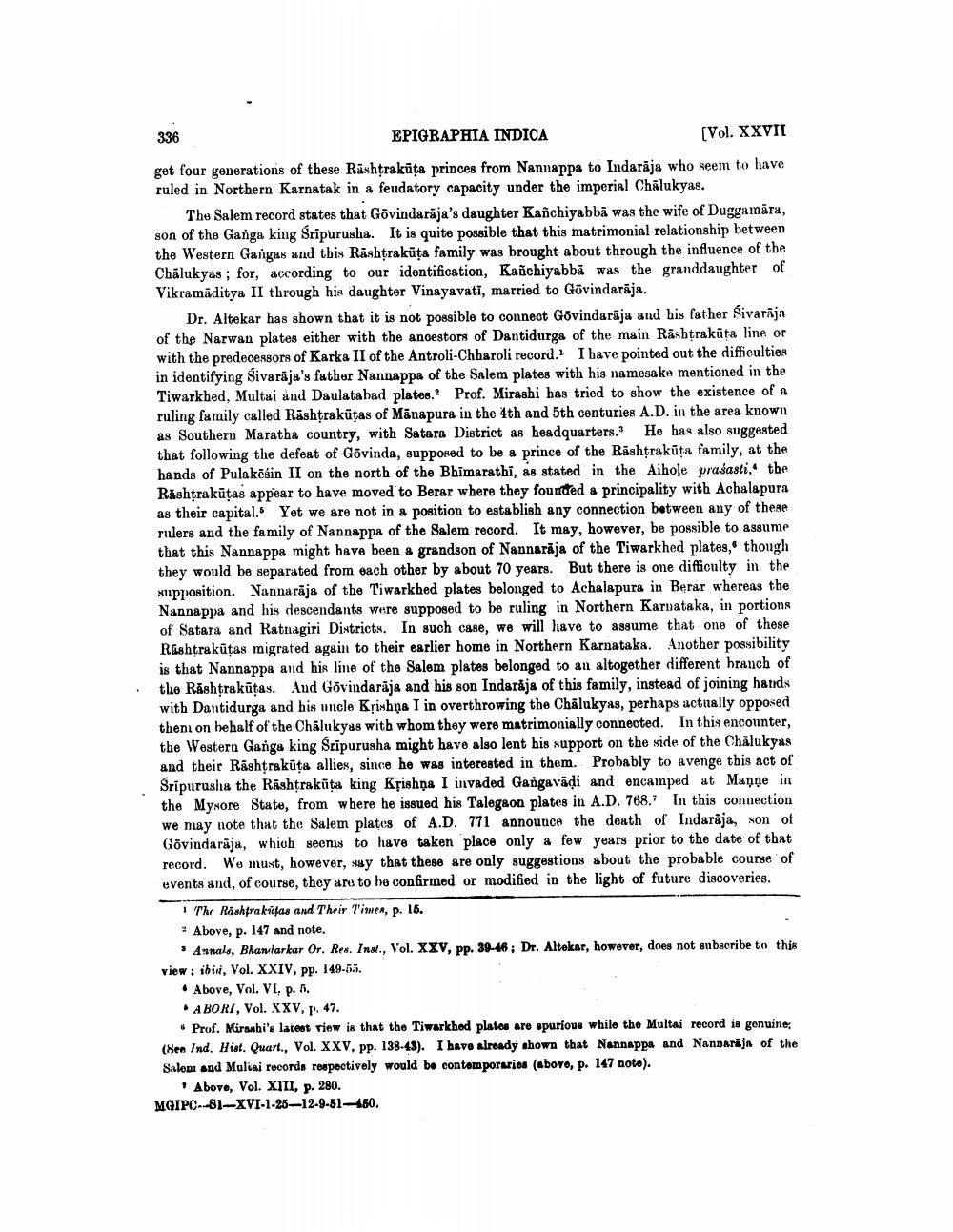________________
336
EPIGRAPHIA INDICA
[Vol. XXVII
get four generations of these Rashtrakuṭa princes from Nannappa to Indaraja who seem to have ruled in Northern Karnatak in a feudatory capacity under the imperial Chalukyas.
The Salem record states that Govindaraja's daughter Kañchiyabba was the wife of Duggamara, son of the Ganga king Sripurusha. It is quite possible that this matrimonial relationship between the Western Gangas and this Rashtrakuta family was brought about through the influence of the Chalukyas; for, according to our identification, Kañchiyabba was the granddaughter of Vikramaditya II through his daughter Vinayavati, married to Govindaraja.
Dr. Altekar has shown that it is not possible to connect Govindaraja and his father Sivaraja of the Narwan plates either with the ancestors of Dantidurga of the main Rashtrakuta line or with the predecessors of Karka II of the Antroli-Chharoli record. I have pointed out the difficulties in identifying Sivaraja's father Nannappa of the Salem plates with his namesake mentioned in the Tiwarkhed, Multai and Daulatabad plates. Prof. Mirashi has tried to show the existence of a ruling family called Rashtrakutas of Manapura in the 4th and 5th centuries A.D. in the area known as Southern Maratha country, with Satara District as headquarters. He has also suggested that following the defeat of Govinda, supposed to be a prince of the Rashtrakuta family, at the hands of Pulakesin II on the north of the Bhimarathi, as stated in the Aihole prasasti, the Rashtrakutas appear to have moved to Berar where they founded a principality with Achalapura as their capital. Yet we are not in a position to establish any connection between any of these rulers and the family of Nannappa of the Salem record. It may, however, be possible to assume that this Nannappa might have been a grandson of Nannaraja of the Tiwarkhed plates, though they would be separated from each other by about 70 years. But there is one difficulty in the supposition. Nannaraja of the Tiwarkhed plates belonged to Achalapura in Berar whereas the Nannappa and his descendants were supposed to be ruling in Northern Karnataka, in portions of Satara and Ratnagiri Districts. In such case, we will have to assume that one of these Rashtrakutas migrated again to their earlier home in Northern Karnataka. Another possibility is that Nannappa and his line of the Salem plates belonged to an altogether different branch of the Rashtrakutas. Aud Govindaraja and his son Indaraja of this family, instead of joining hands with Dantidurga and his uncle Krishna I in overthrowing the Chalukyas, perhaps actually opposed then on behalf of the Chalukyas with whom they were matrimonially connected. In this encounter, the Western Ganga king Sripurusha might have also lent his support on the side of the Chalukyas and their Rashtrakuta allies, since he was interested in them. Probably to avenge this act of Śrīpurusha the Rashtrakuta king Krishna I invaded Gangavadi and encamped at Manne in the Mysore State, from where he issued his Talegaon plates in A.D. 768. In this connection. we may note that the Salem plates of A.D. 771 announce the death of Indaraja, son of Govindaraja, which seems to have taken place only a few years prior to the date of that record. We must, however, say that these are only suggestions about the probable course of events and, of course, they are to be confirmed or modified in the light of future discoveries.
1 The Rashtrakutas and Their Times, p. 15.
Above, p. 147 and note.
Annals, Bhandarkar Or. Res. Inst., Vol. XXV, pp. 39-46; Dr. Altekar, however, does not subscribe to this view: ibi, Vol. XXIV, pp. 149-55.
Above, Vol. VI, p. 5.
ABORI, Vol. XXV, p. 47.
G Prof. Mirashi's latest view is that the Tiwarkhed plates are spurious while the Multai record is genuine, (See Ind. Hist. Quart., Vol. XXV, pp. 138-43). I have already shown that Nannappa and Nannaraja of the Salem and Muliai records respectively would be contemporaries (above, p. 147 note).
1
Above, Vol. XIII, p. 280. MGIPC--81-XVI-1-25-12-9-51-450.




